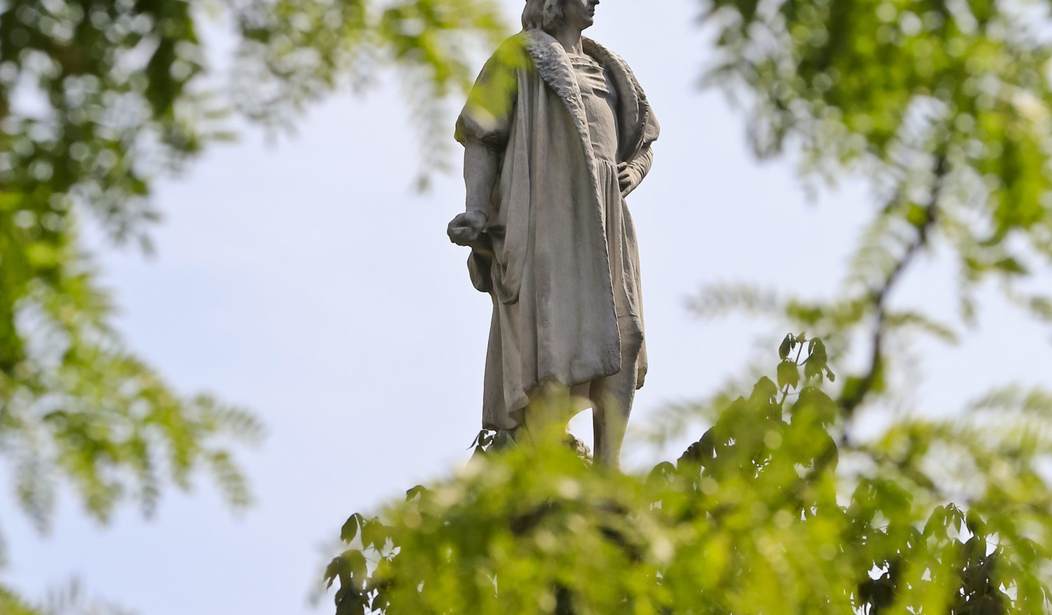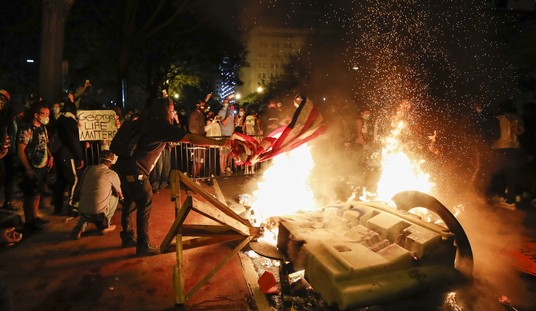We all know that history is not the left’s favorite subject. Many times, it’s just too inconvenient for their political narratives. Often, history has to be erased or submerged in order to achieve the “greater good” of creating a just and moral society.
In truth, it’s not much better on the right, although generally, the conservative take on American history is more nuanced. Christopher Columbus was an ass — a greedy, cruel, ambitious man who didn’t let anyone stand in his way to achieving riches and power, especially native people. But he was courageous enough to cross an unknown ocean in a rickety ship and with a mutinous crew.
Do his sins outweigh the good he’s done? Not our call. And certainly not the call of biased, cretinous leftists who don’t want to understand Columbus and only use his sins as illustrations in their little morality plays to condemn the entire “Age of Exploration.”
Related: We Wouldn’t Have US If Columbus Listened to ‘Experts’
American history did not begin in 1492. There have been human beings residing in North America for at least 20,000 years and probably longer. But the people who crossed the Bering Sea land bridge from Asia to North America during the last Ice Age may not have been the first humans to arrive here. Recent DNA evidence shows that there have been several different migrations to North America with Native American tribes only being the most recent.
And that leads to the inescapable conclusion: the Native Americans who were present on the North American continent when Europeans arrived were not the same Native Americans who arrived 20,000 years ago. DNA evidence tracks the migration of one early American civilization — the Clovis people, so-called because the first tools and weapons were found in Clovis, New Mexico — and reveals that they thrived in both North and South America until about 8500 years ago.
This has been a big debate for some time, that people some 13,500 years ago were making distinct tools that you can find all over the Americas, so-called Clovis Weapons. This is a new style of weaponry: finely crafted, relatively flat spear points no thicker than an envelope, which required unique skills, and therefore stand out in the record.
Something happened, a cultural change or an arrival. For a long time they were seen as the first people. Now, we’re seeing it more as the middle-age arrival in the Ice Age. Where these weapons came from has also been a huge question for archaeologists. Many have been trying to trace them back to the Bering Land Bridge, but the evidence just doesn’t stack up. Others have tried to trace them to an Atlantic arrival by Palaeolithic Europeans around 20,000 years ago.
Any hint that ancient Europeans settled in North America at about the same time as modern Native Americans cannot be countenanced either by Native American tribes or white liberals. For Native Americans, it is a deep insult to their culture to claim that their origins were anywhere else but North America. They reject any migration theories for religious reasons.
The controversy over Kennewick Man shows the lengths that some Native Americans will go to “protect” their culture. A skeleton found in Washington bore some markers of being caucasian. A huge controversy erupted as some Native Americans fought to keep science from unlocking the secrets of the skeleton. After more than a decade of legal wrangling, scientists were allowed to examine the priceless find and the skeleton gave up its secrets. The remains are more closely related to modern Native Americans than to any other living population.
There is also a modern-day political reason for rejecting any hint that Native Americans came from somewhere else.
The idea of coming from somewhere else might threaten the notion that they have primacy on the lands. But, they obviously do because they are coming from these much older stories than anybody else. I look at these stories of arrival and think, “Yeah, they come out of the ground because that is how deep their history goes.” It’s a non-scientific view of the world, but it gives us a window into what it means to be in a place for that long.
So what happened to these older, primitive societies — the Clovis people and others who were clearly present in North and Central America before modern Native Americans? They no doubt had what they considered “their land” to hunt and forage. Who stole it from them and wiped them out?
It’s not a simple question because there are so many holes in our knowledge of early North Americans. There may have been tribal conflicts, and there may have been tribal marriages. The DNA record is silent about land claims, but is that really the point?
What happened to Native Americans when European settlers arrived was as tragic as what happened to the Celtic people when the Slavs and Huns invaded Celtic lands just 800 years before the arrival in North America of Columbus. If anything, the Huns were even more brutal than Europeans were to Native North and South Americans. They also massacred entire villages. They also brought disease and pestilence.
To try and single out what happened to Native Americans as somehow uniquely brutal or unusually evil is ludicrous on its face. It doesn’t make what happened to Native Americans morally right to point out that the entire history of human civilization is replete with examples of deadly contact between civilizations. But it explains it in a way that needs to be understood by everyone — right, left, white, and Native American.
Lore of Plains tribes in North America occasionally features horses, which common knowledge says were not introduced to the Americas until Spanish invasion. Yet early Americans did live with prehistoric horses that went extinct 12,000 years ago. #MythologyMonday
🖼: C.M. Russell pic.twitter.com/9BqH0eXmcq
— Godyssey (@GodysseyPodcast) November 15, 2021
In fact, these conflicts have been part of the march of human progress for tens of thousands of years. Native Americans may mourn their lost lands and be enraged by the killing of so many of their people, but for them to ignore the benefits of contact with Europeans is to ignore reality. There has never been an equal two-way exchange when civilizations clash. White Europeans won out because, as author Jared Diamond points out, they had the “Guns, Germs, and Steel” and Native peoples did not. This didn’t make white society better — only stronger.
Jean Jacques Rousseau, the 18th-century philosopher, saw Native Americans as “Noble Savages” — uncorrupted by anything considered “modern. It’s a racist view of Native Americans but it’s still quite popular among many on the left.
“He believed the original ‘man’ was free from sin, appetite, or the concept of right and wrong, and that those deemed ‘savages’ were not brutal but noble,” explains the website The Conversation. In fact, Native Americans before Columbus lived short, brutal lives — just like white people in Europe did. They could be just as devious as any white Europeans. They could lie like white Europeans. They could kill just like white Europeans. Native Americans didn’t need white Europeans to teach them these things.
In American politics today, we don’t do nuance. If the argument can’t be reduced to 140 characters, it’s not made. But as a society, we don’t dwell on the past very much — a failing and a huge advantage given the Jekyll and Hyde nature of our history. “Why is it we hear the loudest yelps for freedom from the drivers of Negro slaves?” asked British writer Samuel Johnson. It’s a duality that continues to bedevil us as we move further along into the 21st century.










Join the conversation as a VIP Member